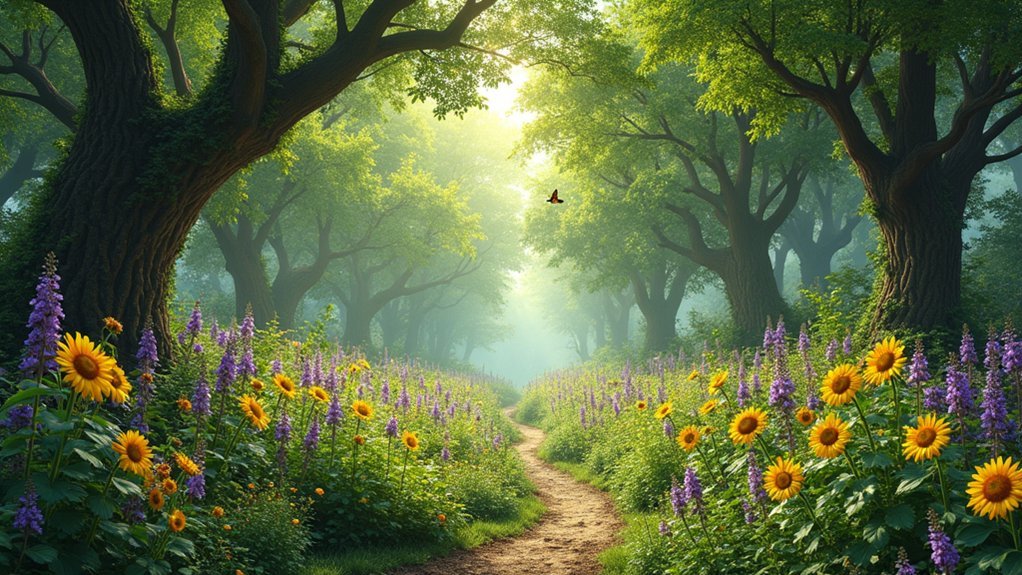Food forests build wild pollinator corridors by mimicking nature's multi-layered design, providing year-round food sources through diverse plant species. They connect fragmented urban green spaces, supporting 75% more pollinators than conventional landscapes. You'll also create seasonal diversity with continuous bloom sequences that prevent resource gaps threatening pollinator survival. These living ecosystems offer essential nesting sites while enhancing climate resilience—key benefits that transform your garden into a vital link in the pollinator pathway.
Mimicking Natural Ecosystems: How Food Forests Provide Multiple Pollinator Resources

While conventional agriculture often creates monoculture deserts for wildlife, food forests stand as vibrant sanctuaries for pollinators by replicating nature's diverse design.
When you incorporate native plants throughout your food forest, you're creating a thriving ecosystem that supplies year-round resources for pollinating insects.
The multilayered structure—from canopy trees to ground covers—offers diverse food and habitat opportunities that essential pollinators need to survive.
By selecting native species that flower at different times, you'll establish a continuous buffet of nectar and pollen throughout the seasons. This abundance attracts and sustains everything from bees to butterflies to beneficial wasps.
Your food forest becomes more than just a food production system; it transforms into a pollinator pathway that connects fragmented landscapes, helping combat the alarming 75% decline in flying insect populations.
Connecting Urban Green Spaces Through Edible Corridors
As expanding populations threaten natural landscapes, edible corridors emerge as essential lifelines connecting fragmented urban green spaces. You'll find initiatives like Maryland's Community Food Forest integrating native and edible plants to support both pollinators and urban wildlife amid growing climate change concerns.
| Corridor Benefits | Biodiversity Impact | Community Action |
|---|---|---|
| Links green spaces | Supports 75% more pollinators | Plant 25+ native species |
| Creates food sources | Counters insect population decline | Join local forest initiatives |
| Provides habitat | Enhances ecosystem resilience | Participate in urban gardening |
| Mitigates fragmentation | Increases plant diversity | Share harvests locally |
| Improves climate resilience | Supports native wildlife | Promote environmental stewardship |
Seasonal Diversity and Year-Round Habitat for Native Pollinators

The beauty of food forests extends beyond mere connections between urban spaces—they create living sanctuaries that pulse with life throughout the seasons.
By establishing a continuous bloom sequence, you're providing food for native pollinators year-round, ensuring they don't face resource gaps that threaten their survival.
Nature thrives in continuity—your garden's year-round blooms create the lifeline pollinators need to survive modern landscapes.
Your food forest's multi-layered structure offers essential nesting sites while nitrogen-fixing plants contribute to soil health, adding nutrients that support robust plant growth.
This seasonal diversity—from early spring blossoms to late autumn flowers—creates thriving habitats that sustain pollinator populations through changing conditions.
When you connect these pollinator-friendly spaces, you're facilitating movement across the landscape, allowing for genetic diversity within pollinator communities.
This resilience is vital as bees, butterflies, and other beneficial insects navigate increasingly fragmented environments.
Frequently Asked Questions
What Is Pollinator Corridors?
Pollinator corridors are connected pathways of native plants you'll establish to help bees, butterflies, and other pollinators travel between fragmented habitats. They're vital lifelines that provide food and shelter for these essential creatures.
How Do You Make a Pollinator Habitat?
You'll need to plant diverse native flowers that bloom year-round, create habitat islands, provide water sources, establish structural diversity with trees and shrubs, and maintain a pesticide-free environment for pollinators to thrive.
What Materials Can Be Used to Build a Pollinator Habitat?
You'll need native plants like milkweed and black-eyed Susans, shrubs such as blueberry, water features, logs, rocks, brush piles for shelter, and compost areas to build an effective pollinator habitat.
What Are the Pollinators in the Forest?
In your forest, you'll find diverse pollinators including honeybees, bumblebees, solitary bees, butterflies, moths, and birds. They're essential for plant reproduction and maintain the ecosystem's health through their pollination activities.
In Summary
You've seen how food forests create powerful pollinator pathways by mimicking natural ecosystems, connecting fragmented urban spaces, and providing year-round habitat diversity. Now it's your turn to transform your land into a thriving corridor. Whether you're planting a small garden or managing acres, you're not just growing food—you're rebuilding essential habitat networks that wild pollinators desperately need to survive our changing world.





Leave a Reply